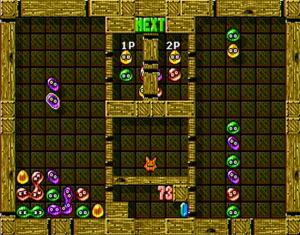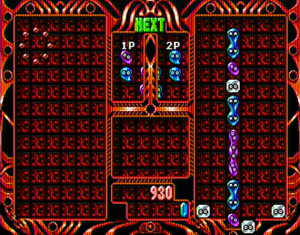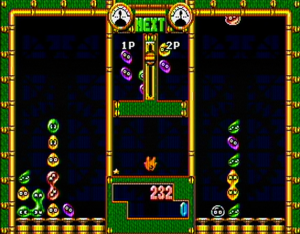
3D Puyo Puyo 2, better known under the Japanese name Puyo Puyo Tsu, is one of several games as part of the upcoming SEGA 3D Classic Collection. Puyo Puyo Tsu is considered an arcade classic in Japan, with it being played on a high level even today and setting the standards for future Puyo Puyo games like the concept of offsetting, All Clear, and standardizing four colors. But playing the game might be intimidating since for people this might be the first time playing the game. Luckily this guide will explain how the game works so you can feel more confident.
Before we begin, let’s just clarify a few things.
- This game is not Dr. Robotnik’s Mean Bean Machine or Kirby’s Avalanche. Those games were localized versions of the first arcade game Puyo Puyo, Puyo Puyo Tsu is the sequel and as such should stand on it’s own.
- 3D Puyo Puyo Tsu is based on on the arcade version of Puyo Puyo Tsu. There may be differences between that version and other versions. Screenshots will be based on the (almost) arcade perfect Mega Drive version.
- This article will cover modes that appear in the arcade version. Modes introduced in later ports such as Rally Mode and Practice Mode will not be documented.
Single Player

Single player adapts a unique tower system in this game. Arle enters a tournament set up by Satan that recruits the best Puyo Puyo players out there, and as Arle your job is to climb up a tower by beating these opponents. As mentioned you’re goal is to climb up the tower by beating your opponents, but the opponent you face is randomized using a roulette like system. If you are worried about having to deal with luck based gambles, the good news is the roulette is very lax, as pressing the button will instantly select whatever it’s currently on and the roulette will gradually slow down. The exception to the rule is the final floor, where you’ll face off against Schezo, Rulue, and Satan (or Masked Satan under certain conditions) in order.
 You’ll be given a brief description on who they are, and afterwards you’ll play against them with the intent of beating them. But beating your opponents has a catch. You need to score enough points to climb up the tower, and depending on your performance you may need to keep beating opponents until you earn enough points and move on. You face each opponent once, and if in the scenario they’re all cleared without you moving on, you’ll face against a hidden opponent. If that opponent is defeated and you still didn’t get enough points, Arle will be booted from the tower and the game ends. Luckily the scenario of that happening is nearly impossible.
You’ll be given a brief description on who they are, and afterwards you’ll play against them with the intent of beating them. But beating your opponents has a catch. You need to score enough points to climb up the tower, and depending on your performance you may need to keep beating opponents until you earn enough points and move on. You face each opponent once, and if in the scenario they’re all cleared without you moving on, you’ll face against a hidden opponent. If that opponent is defeated and you still didn’t get enough points, Arle will be booted from the tower and the game ends. Luckily the scenario of that happening is nearly impossible.
 As you climb the tower, the game will gradually increase in difficulty. The drop speed of Puyo will increase, the opponents you face will become more savvy, you’ll need to earn more points to continue, and you will have less opponents to face and therefore tempt the above mentioned scenario. In addition, the opponents you face will sometimes utilize a gimmick that may throw off players. For example the character Nohoho will fill up the right three columns on his field and then bank on getting a big chain, and Harpy will fill the first and sixth columns.
As you climb the tower, the game will gradually increase in difficulty. The drop speed of Puyo will increase, the opponents you face will become more savvy, you’ll need to earn more points to continue, and you will have less opponents to face and therefore tempt the above mentioned scenario. In addition, the opponents you face will sometimes utilize a gimmick that may throw off players. For example the character Nohoho will fill up the right three columns on his field and then bank on getting a big chain, and Harpy will fill the first and sixth columns.
Opponents
Floor 1
- Skeleton-T
- Will o’ Wisp
- Sukiyapodes
- Trio the Banshee (aka Banshee Trio)
- Nomi
- Momomo
- Baromett
- Mini Zombie
- Masked Satan*
Floor 2
- Panotty
- Uroko Sakana Bito (aka Seriri)
- Nohoho
- Cait Sith
- Fufufu
- Mummy
- Owlbear*
Floor 3
- Sasori Man
- Samurai Mole
- Harpy
- Parara
- Nasu Grave
- Zombie*
Floor 4
- Suketoudara
- Mamono
- Witch
- Pakista
- Dragon*
Floor 5
- Draco Centauros (aka Draco Centaur)
- Minotauros (aka Minotaur)
- Zoh Daimaoh*
Final Floor
(Note: Opponents are faced in subsequent order)
- Schezo Wegey
- Rulue
- Satan or Masked Satan**
*Hidden opponent; must beat all other opponents to encounter.
**Masked Satan needs 180,000 or more points and no used continues to encounter.
(Note: Later ports such as the SEGA Saturn and Playstation versions would also include the characters Lycanthrope, Scylla, Incubus, and Cockatrice.)
Score Target
The Score Target is how many points you need in order to move onto the next floor. The exact amount varies with the version, but these are based on the arcade and Mega Drive versions.
Floor 1: 15000
Floor 2: 45000
Floor 3: 80000
Floor 4: 120000
Floor 5: 150000
Multiplayer

(Note: 3D Puyo Puyo Tsu utilizes local multiplayer. Risks of lag or disconnects are possible due to being wireless, please ensure you stay close and out of the way of any objects to reduce the chances of lag)
Puyo Puyo Tsu is fondly remembered for it’s multiplayer feature. It has been hailed as a surprisingly deep experience due to the perfect blend of features that expands and improves on what the first arcade game Puyo Puyo established. In the game’s multiplayer mode, two players face off against each other to see who has the supreme skills. In the arcade version, players will keep on playing as long as credits are inserted into the machine, while for later ports players can adjust a set goal like best out of three or best out of five. The player has the option to pick 6 different boards, each board having a different gimmick like utilizing special Point Puyo or Ice Puyo, with the exception of the wood tile board which uses the standard rules.
How the game plays is similar to the first arcade game Puyo Puyo. There are 6 columns and 13 rows, with the 13th row being hidden, meaning a board can hold up to 72 Puyo at a time. If the 3rd column, 12th row is blocked, the player is knocked out. The player rotates Puyo clockwise and counterclockwise with the “bottom” Puyo acting as the pivot, pressing down manual drops, and moving Puyo using the left and right direction. The objective of the game is to knock out your opponent by sending a type of Puyo called a Nuisance Puyo onto their field. To do this, the player must set off chains, with larger chains meaning larger amounts of Nuisance Puyo. How much Nuisance Puyo you send is influenced by your chain, how many different Puyo you pop simultaneously, and how many Puyo you pop within a chain. The good news is that Nuisance Puyo can be removed by setting off chains adjacent to them, the bad news is that as their name implies they often disrupt you building chains.
In addition, Puyo Puyo Tsu adds several more features.
Offset


Introduced in this game is the ability to offset Nuisance Puyo. Above a player’s board there is a space where Nuisance Puyo are displayed, which normally drop after the next Puyo is placed. However if a player sets off chains before it drops, the Nuisance Puyo dropped will be reduced. If you can create a large enough chain, the player can completely erase all of the Nuisance Puyo or even send it back at the opponent. This feature encourages players to mix bombarding the opponent with weak chains and slamming the opponent with a large chain. Future titles would expand on this feature further, like Puyo Puyo Sun and Puyo Puyo Fever.
All Clear

All Clear is a feature where if a player cleans out their board, they will receive a bonus. In Puyo Puyo Tsu, an All Clear will cause the player to send an additional 30 Nuisance Puyo at the opponent when the next chain is set off. Sometimes due to the random number generator, both players can receive a “freebie” at the beginning of a match due to receiving four of the same color.
Margin Time
Margin Time is a hidden point system that influences how strong the Nuisance Puyo multiplier is. When the seconds of a match equals the hidden number, the points will begin to decrease by being multiplied by 0.75 every 16 seconds and will continue to decrease until it either reaches 1 or goes through 14 intervals. As the number decreases, the Nuisance Puyo multiplier will increase. By default Puyo Puyo Tsu uses a score of 96. This mechanic is included to prevent matches from dragging too long. Hypothetically if all the points are drained, a standard 1 chain has a enough power to make 40 Nuisance Puyo.
Handicap

Handicap has been overhauled in this game. By default the player utilizes four different colors, but with adjustments to the handicap the player has the option to pick three or five colors. The more colors the player has to deal with, the harder the game gets.
- 3 colors
- 3 colors + 2 rows of Nuisance Puyo
- 4 colors (default)
- 5 colors
- 5 colors + 2 rows of Nuisance Puyo
Double rotation
In Puyo Puyo Tsu and future games, in the situation where a player’s piece is wedged between Puyo, they have the option to rotate the Puyo at a 180° angle by pressing one of the rotation buttons twice.
Boards

Unique to Puyo Puyo Tsu is the ability to pick a selection of 6 different boards, each hosting a different gimmick.

The wooden field utilizes the standard rules. Use this if you want straightforward matches

The block field utilizes a type of Nuisance Puyo called Ice Puyo. Ice Puyo are removed by clearing chains around them twice.

The ballroom field utilizes a type of Nuisance Puyo called Point Puyo. Point Puyo boosts the power of chains when cleared.

The bronze field uses only two colors by default, the catch being that you need to connect 6 or more Puyo in order for a chain to count and Ice Puyo are utilized.

The golden field causes all Puyo to pop if they are connected by 2 or more. This means any pairs of the same colors will instantly pop.

The mechanical field allows players to customize matches to whatever they want, for example adjusting how many colors are used or how large the margin time is.
Tips
- Pay attention to your opponent’s board and the sound effects, it can give a hint of what your opponent plans to do. For example if no sounds are heard, the opponent is slowing down to form a strategy, while sound effects like a lightening sound or Arle yelling “Bayoen!” hints that you’re going to be hit with a large chain.
- Creating a large chain can ensure a victory, but sometimes peppering your opponents with a lot of weak chains is equally effective since it prevents them from recovering and disrupts their chaining. For example, if the opponent is buried under Nuisance Puyo and are trying to dig out.
- Stacking high can be an effective defensive tool. Nuisance Puyo always drop at 30 maximum in intervals, which can be taken advantage of in order to absorb a hit and still retaliate. These types of chains are referred to as a Counter.
- There is a hidden 13th row. When Puyo are in that row, they still exist but aren’t counted until they are from the twelfth row or below. It’s possible to further extend a chain using this “ghost” row that wouldn’t be possible otherwise.
- It’s possible to stall for a few seconds by rotating the Puyo on the ground back and forth. Any Nuisance Puyo won’t drop until your Puyo are set in place, so utilize this if you need a quick second to think of a strategy.
- A basic way to practice chains is to practice chain types called Sandwiches and Stairs. Both are straightforward chain types that helps you learn the rules of how chains work.
I hope this quick article will help someone out there. Puyo Puyo is celebrating its 25th Anniversary in Japan, so to see a game come out in North America is a nice gift. 3D Puyo Puyo 2 will be apart of SEGA 3D Classics Collection.
Stay tuned for our review of the collection, which will publish April 22nd. Pre-order SEGA 3D Classics Collection today from Amazon or from wherever you buy new games, the game releases April 26th.
Ad:





Nicely detailed tips! I’ll probably use this guide when 3D Classics comes out as I’m fairly decent at Puyo Puyo.
I’ve fond memories of playing Puyo Pop on the GBA back in high school. My friends and I would link up and battle it out in 4 player mode during every lunch break we had. So much fun. It’s a bit upsetting that a lot of the newer Puyo games aren’t getting localized much, like Puyo Puyo Tetris, but I’ve managed to import them and play them, and it’s still every bit as fun as I remember. Looking forward to picking up the SEGA collection just for this game alone.
“Masked Satan needs 180,000 or more points and NO USED CONTINUES to encounter.”
Well, thanks to save state feature on 3DS version, I could finally faced him.
Already imported the game btw, since I’d never expect the game to be localized back then.
Thanks for this guide! The only Puyo Puyo games I played are Puyo Pop Fever, Dr. Robotnik’s Mean Bean Machine, and the Puyo bonus game in the 3DS Hatsune Miku game. I’ll make sure to use this when I get my copy on the 26th!
I can do some ‘Stairs’ combos. They’re probably the easiest one
Unfortunatelly I can’t do more than 6-7 chains
If you are unable to do more than 6-7 chains then you probably need to learn Transitions. Transition is where you extend your chain by building upward. Transitions are one of the hardest to setup due to requiring 2-3 same color pieces in a row. My advice is always try to build the transition first.
http://www.puyonexus.net/chainsim/?chain=7020027720025720027720027424724424724424724
Instead of extending the chain as shown in the middle, try to build the transition first like on the left side. You can build transition using 3 long (left) or 2 long (right). It’s MUCH easier if your transition is 1 long 3 colors instead of 2. The odds are higher of being able to complete the transition with a 3 long.
Also I should tell you, once you you master Stairs and Transition, you’ll discover Stairs is almost useless to extend the chain further lol. The 1st 6-7 chains are built at the bottom, called 1st Floor (Bottom Floor). The chain above it, I refer to as 2nd floor. The reason why Stairs work poorly on the 2nd is because Stairs require too much vertical space and very prone to color conflict (unintended chain reaction).
Transitions will be hard at first. Keep practicing to build speed. I usually can make double digit chains pretty fast 🙂